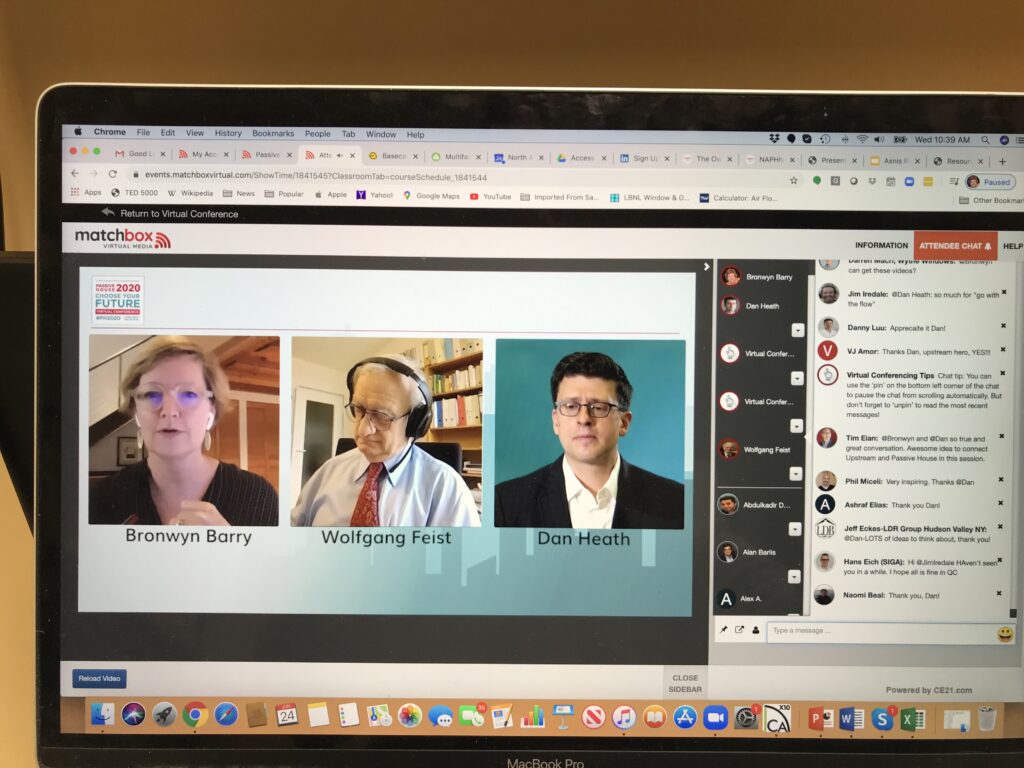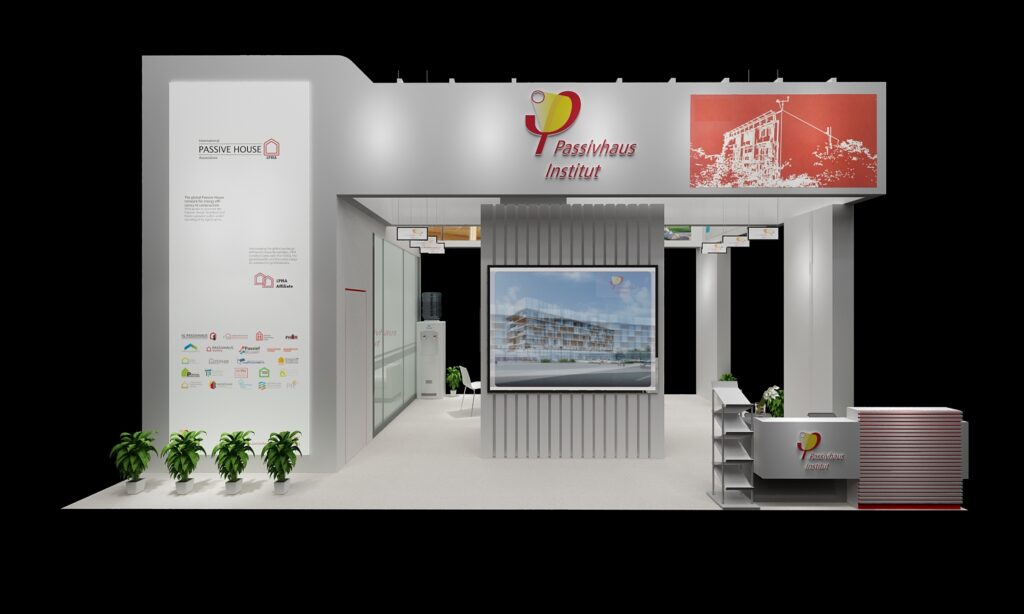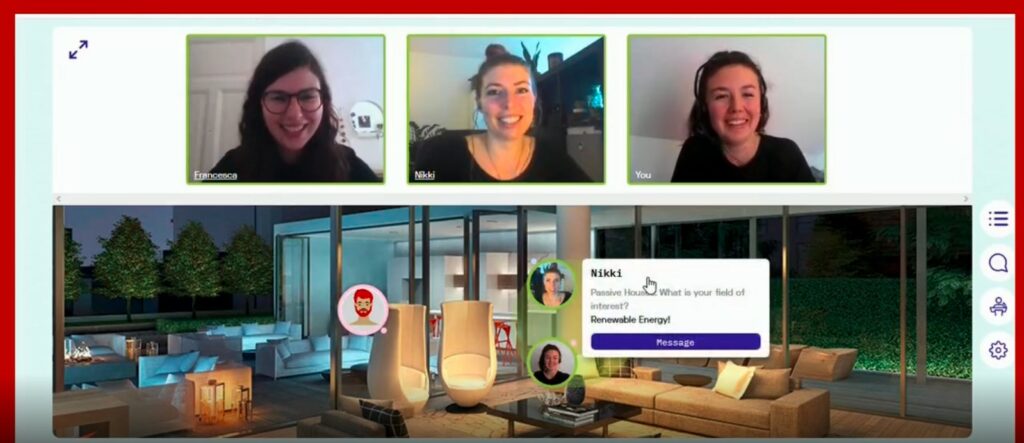
In May of 2020, after much deliberation, the Passive House Institute announced that the 24th International Passive House Conference would be offered as a comprehensive online conference. How did they do it? What was that process like? We sat down with the two main players of PHI’s conference planning team, Cornelia Baumgärtner and Luzia Teinert to ask them!
If you want to know more about the conference set up, the programme, then you should definitely read one of our latest blog posts 6 Highlights of the 24th International Passive House Conference – Virtual Edition.
Alternatively, if you’re more of an auditory learner, you can check out this recorded iPHA webinar on our Youtube channel. In the video, Cornelia (Conny) and Luzia discussed the format of the virtual conference, the registration procedure, the online manufacturer’s expo, and virtual social events that will take place over the course of the conference, and more.
With these sources, we know what, where, and when about the first-ever virtual conference. The purpose of this interview, however, is to ask how it all happened…

So, by now we all know that the 24th international conference will be held virtually. What was the discussion leading up to this decision?
[Conny] Our conference is something very special, because we have guests coming from all over the world. When the worldwide lockdown hit in March 2020, we were certain that the conference could not take place as usual.
[Luzia] Yes. It took a few weeks to make the final decision and then the announcement that we would have the conference in an ONLINE format. Today we know that this was really the only right decision.
Where did you even start? Are there resources out there on how to plan an online conference from scratch?
[Connie] The goal was to make the ONLINE conference as close as possible to the in-person conference. Which was something that we had to develop from scratch, while drawing on some experience gained in our online webinars. In addition, the exchange with our partners definitely helped, because this situation presented us all with new challenges.
NAPHN, specifically, is one of our close partners who just had their virtual conference in June and July. Did you have a lot of exchange with them?
[Conny] Yes. Definitely. Shortly after we made the decision to do everything online, I had a call with Ken Levenson that lasted an hour or so, which was very helpful. He had shared with us what NAPHN’s plan was, and we took a lot of inspiration from that. That was how we decided to do the presentations as pre-recorded videos, for example, instead of live videos. NAPHN did that and it worked out very well for them.

| Featured in our interview with Brownyn Barry.
You know, when you have speakers coming from all over the world, there a lot of factors you have to consider in a live presentation (time, internet connection, access). It would be just too much. Instead we decided to have recorded videos and a live introduction and then Q&A portion following the presentation
[Luzia] This was one of the first things we decided, yes.
So, if I understand this correctly, you guys had already begun planning a lot for the originally planned conference in Berlin in October correct? How far did you get into the planning?
[Conny] Usually we book the location for the conference 2 years in advance. So that was set. At the beginning of 2020 we had already reserved the hotel rooms and workshop rooms. By March, half of the exhibition stands for the trade exhibition had been booked. So quite a lot.
[Luzia] Nobody could have foreseen the necessity for this virtual format. We are definitely happy that everyone, including even the local institutions we had been in contact with in Berlin, are supportive of this new online format.
What about the virtual conference is the same as the one planned for Berlin? What will be different?
[Luzia] The programme is very much the same. The contributions were already submitted and evaluated before the lock-down, as the Call for Papers deadlines was back in March. So, as usual, the conference will feature 16 sessions on different topics, each with about 6 presentations. Unlike usual, the program will take place over a period of 3 weeks instead of 2 days. And each day will have multiple sessions. So it’s the same topics… but everything online.
[Conny] The Exhibition was also something that was very important for us to keep. To continue working with those Exhibitor partners that we have had for years, and allow them to participate and present their products. Now, with the ONLINE Exhibition, I think this makes our conference special compared to previous virtual conferences. We hope to have a long list of Exhibitors joining us for this…experiment [laughs].
Well the pro of the ONLINE Exhibition over the traditional in-person one is that the ONLINE Exhibition is open 24/7 right? For a few weeks even…

[Luzia] Yes, definitely.
[Conny] And it starts on the 17th of September, so 3 days before the conference. We figured that the last few days before the conference would be when most people would register on our website for the conference. So we thought maybe when people visit the conference page, they would also see the Exhibition and think “Oh, cool that’s open now, let me see what is going on there”. We want to use the traffic on our website and turn that into traffic for the Exhibition.
That’s smart. Obviously, you guys have put a lot of thought into it.
[Both] [Laughs]
[Conny] We try to.
So the speakers were all kept the same, they just needed to change their presentation format. Now rather than getting to perform live before an audience, they will need to take a video of themselves presenting. What was the feedback that you got from speakers when you told them of this new requirement?
[Conny] I did have one call with a speaker who said that he would miss the live presentation. He said he loves doing his presentation live because you get that feedback from the audience. He said he isn’t even prepared for his presentation when he steps on the stage, and he kind of just goes with the flow. But this was just one conversation.
I think all of our speakers are very understanding of the changes. There were really only two options: virtual conference or no conference. I think everybody would rather adjust to this online format than have a year without the International Passive House Conference.
Can you talk briefly about the format of the presentation for those that might not yet know?
[Luzia] So during each session, there will be an introduction by the moderator, followed by 3 presentations, then there will be a live Q&A discussion with the 3 speakers where they elaborate further on questions asked in the chat. And this will repeat over and over again, which is different from the normal conference pattern where you would have a presentation and then right afterwards have questions.
[Conny] Yes there is this live Q&A section, AND there is the opportunity for speakers to answer questions in the chat during the video presentations. Not only speakers but also other participants can answer questions and discuss. It’s more interactive. This was something that was done during the NAPHN conference as well. For example, there were PHI people taking part in the conference who were also there and able to answer tricky technical questions. This is something we are also hoping to see during our conference. And I think this is a real advantage of the online conference.
So to recap: All the topics and events are the same… Just how they are presented is different, correct?
[Conny] Yeah. We hope so [laughs].
[Luzia] Oh and the time period.
[Conny] That’s right the time period. Normally the conference would happen over two days of in-person events. But, like we said, it’s now over a few weeks, with just two sessions a week. So now, hopefully, people can do the work they need to do during the week AND take some time in the morning or in the evening for a bit of Passive House Conference. [Laughs]

Well yeah. That brings up a good point. What was the motivation for spreading out the conference this way? Because, in theory, you could have also just set it up over only 2 or 3 days back to back.
[Conny] So I think the main thing is: we have no idea how smoothly things are going to run. When we split it up this way, it makes it possible to change things and adapt from one day to the next. Were we to do this over just two days, we would have no chance to make things better. So with this schedule, we are giving ourselves time to update and improve things over the weeks.
[Luzia] And also I think we learned from our own experience with online meetings and webinars that when you are watching a presentation online, you have to shorten it to keep people’s interest. For whatever reason, in real life, you can sit and watch a presentation for longer than online. So that was something that we also wanted to take into account.
Would you say that planning a virtual conference has been more or less challenging than the past in-person ones? I am going to go ahead and assume that the answer is more but I will let you talk about why.
[Both laugh]
[Conny] Well yeah because we don’t really know what is going to happen. We’ve tried to learn from the experiences of our partners and imagine what will happen, but really we don’t know. We’ve really tried our best. The software, for example. We took months to figure out the best software to use, and then last week we decided to change everything. Because we are always learning new things and having to take new things into account. It’s very difficult to make a right decision about what to do when you don’t know everything. We are always having to ask ourselves “Will this even work?”
At a normal conference you typically have people at the conference centres that are there to help you with the planning and organisation. And you have a picture in mind of what need to happen and you just need to check things off the list. But now, we need to do research and ask ourselves “What even is the thing that we need to do?”. And this research takes so much time…
[Luzia] So much time. There are so many possibilities out there for things to do with a virtual conference. So now we have to decide, ok, which of these billion options do we want to use? And which one is the best one for our conference? We have to think of everything in a new way and constantly learn new things.
[Conny] [Laughs] I’ve learned something new every day this year since March, for sure. Now I can tell you exactly which software goes with what solution. Things that I never thought I would have to learn in my lifetime.
[Luzia] Yeah. A really big challenge has been learning how we can make our conference available to everyone all over the world. Every country has different rules and regulation. In China, for example, there are lot of restrictions. In Germany, in some cases, Zoom is not allowed. And in other countries, there are other tools that are not allowed. But it is so important for us for members of the Passive house community all over the world to be able to fully take part.
Also, including networking opportunities in the virtual conference was challenging. Networking is such an important part of the traditional conference, so we wanted to make sure we included it in the online conference. But I think we figured out a way to do that with the tools that we’ve chosen.

What do you think is the most beneficial aspect of a virtual conference?
[Conny] I think the main benefit is the ability to watch all the sessions. In the past Passive house conferences, because multiple presentations are going on at once, you had to pick and choose which ones to watch. But now that they are recorded, you can watch every single one. Also, you don’t need to travel! Which hopefully saves a lot of time and money for all of the conference participants. Especially because the conference ticket is so much cheaper now too.
How many people are expected to participate? So attendees, speakers, and exhibitionists?
[Luzia] That’s actually a really difficult question. Normally we would expect a maximum number of around 1000 participants for the conference. So we expect probably something around that figure. But because there is no limit on the number of participants, and everything is online and theoretically more accessible, we could see even more than that. It’s hard to know. We will let you know once it’s over [laughs].
What has been your most asked question during the planning of this conference?
[Luzia] I think the main question asked of us has been “What software are we using?” However, I think with all of these changes, something that we have been asking ourselves for sure is “How will people react to this new format? Will they accept it” We will see…
Obviously it is much too soon to say officially, but do you think there will be aspects of the virtual conference that will be included in future conferences?
[Luzia] Yes I think so. I, personally, have the feeling that a lot of things are changing. The pandemic caused a lot of rethinking, and it definitely something we can learn from. We are thinking that in the future we might broadcast parts of the in person conference. That way we can make at least parts of the conference available for those who might not be able to make it to the conference.
[Conny] Yes, I think is makes sense to include what we’ve learned in future conferences and have some online aspect to it. But it also makes sense to go back to meeting in person. We are human, you know, and I think that having that in-person connection is important, especially for growing the Passive House community. Handshakes, body language, looking into other people’s eyes. Those things are all an important part of the conference experience.
What is something that you want conference attendees to know going into the 24th international Passive House conference?
[Conny] Take advantage of everything that is offered! If you’ve never participated in the Passive House conference before, but you are interested, now would be the perfect opportunity to try it out. Come and meet the Passive House community. I think it’s the community, really, that is one of our biggest advantages. It’s a community of genuinely nice people that want to help each other out.
[Luzia] I would add, we also want to be open for everyone who might be interested. Even people who are outside the building sector or climate protection sphere, but you can join and network and ask questions and learn new things too. We are really open to everyone who is interested.
A huge thank you to Luzia and Conny for taking the time to answer our questions! We hope you’re as excited about the upcoming conference as we are and we can’t wait to see you there!
Still have questions? Definitely take a look at the recording of the info session webinar where the conference team explained the structure and features of the conference in detail. You can also always visit the conference website which is constantly being updated and now includes a FAQ section or send an email with your questions to conference@passiv.de






 Carl supports our international communication activities and is the point of contact for administrative enquiries.
Carl supports our international communication activities and is the point of contact for administrative enquiries.